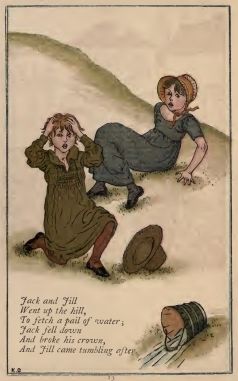nn
n
n
n
n When we talk about the Man in the Moon, our mind’sneye conjures a picture coloured by images of the Moon’s face similar to thatnseen in Georges Méliès’s 1902 film, A Voyage to the Moon.
n
n
n
 |
| A Voyage to the Moon |
n
n
n
nInvariably, wenimagine a face, with the features formed by the craters, ridges and mountains,nbut in the past there was a different Man in the Moon, who was seen as a fullnfigure of an old man, bent over by the burden of the firewood carried on hisnback, and sometimes accompanied by a small dog scampering at his feet.
n
n
n
 |
| Can you see him? |
n
n
n
nAn OldnNorse myth tells that the Moon, Mâni, stole two children, Hjukinand Bil, from the earth as they were collecting water from the well, Byrgir,nin their bucket, Sœgr, suspended from their pole, Simul. Hjuki,nin Norse, is prounounced Juki, which becomes Jack, and for the sake of euphonynBil becomes Jill. We have the tale of Jack and Jill, who went up the hill tonfetch a pail of water. Moreover, Hjuki comes from the verb jakka – tonpile up or increase, and Bil derives from bila – to dissolve or fallnapart, so the story of Jack and Jill is actually all about the waxing and thenwaning of the moon, and the pail of water is a reference to the moon’s pull onnthe tides and its influence on rainfall.
n
n
n
 |
| Jack and Jill |
n
n
n
nThe idea that Mani stole the childrennrelates to the tradition that the Man in the Moon stole the sticks he carries,nand it was for the crime of theft that he was placed in the moon. Later, whennNorthern Europe was Christianised, the myth was hijacked and adapted to saynthat the Man in the Moon was the man found by the Hebrews gathering sticks onnthe Sabbath, an act forbidden by God, and brought by them before Moses, whonordered that he was to be stoned to death for his transgression (yep,napparently it’s fine to stone people to death on the Sabbath but not to pick upnsticks for your fire. Book of Numbers, Chapter 15. Look it up.)
n
n
n
 |
| … Pick up Sticks |
n
n
n
nJack wasneventually turned into the Man in the Moon himself and Jill was forgotten. Annancient English ballad from the thirteenth century tells his story,
n
n
n
n“Mon innthe mone, stond ant streit;n
nOn is bot-forke is burthen he bereth:n
nHit is muchenwonder that he na down slyt.n
nFor doute leste he valle he shoddreth ant shereth.”n
n[Man in the moon, stand and stit!n
nOn his bot-fork his burden he beareth;n
nIt isnmuch wonder that he does not down sit;n
nFor doubt lest he fall he shudd’reth andnshivereth.]n
n
n
n
n
 |
| Mon in the Mone |
n
n
n
nThe old man, with his pitchfork and bundle of sticks, has been putnin the moon for ‘pycchynde stake’ (picking stakes), on a Sunday. In thenmid 1330s, one Walter de Grendene sold some land and a barn to his mother, thenseal on the deed shows a man with a bundle of sticks and surrounded by thenwords,
n
n
n
n“Te Waltere docebo cur spinas phebo gero”n
n
n
n
n
 |
| Man in the Moon Seal |
n
n
n
n(‘I will teach you,nWalter, why I carry thorns in the moon’ – which, more or less, means ‘honestynis the best policy’).
n
n
n
nThis idea that a man lived in the moon can be seen from anproverbial expression used by Chaucer about fifty years later, in Troilusnand Criseyde, where he urges caution “… lest the churle may fall out ofnthe moone”. Shakespeare used the same legend in A Midsummer Night’snDream, where Moonshine says,
n
n
n
n“All that I have to say, is, to tell younthat the lanthorn is the moon; I, the man i’ the moon; this thorn-bush, mynthorn-bush; and this dog, my dog.” nn
n
n
nAnd in The Tempest, Caliban and Stephano say,
nnn
n
n
nCal. Hast thou not dropp’d from heaven?nnn
nSte. Out o’ the moon, I do assure thee. I was thenman i’ the moon, when time was.nnn
nCal. I have seen thee in her, and I do adorenthee: my mistress show’d me thee, thy dog, and bush.n
n
nnn
nAnother playwright (who was an influence onnShakespeare), John Lilly, in the prologue to his Endimion, has thenlovely line,
n
n
n
n“…there liveth none under the sunne, that knowes what to makenof the Man in the Moone.”n
n
nnn
 |
| The Man in the Moon drinks claret |
n
n
n
nIn later years, the moon was thought to drinknclaret, in reference to the blood red moon that happens during a lunar eclipse,nas this rhyme says,
n
n
n
n“Our man in the moon drinks clarret,nnn
nWith powder-beef, turnep, and carret.nnn
nIf he doth so, why should not younnn
nDrink until the sky looks blew ?”n
n
nnn
n
n
 |
| Blood Red Moon |
n
n
n
nAnd another, similar, rhyme says,
n
n
n
n“The man in thenmoon drinks claret,nnn
nBut he is a dull Jack-a-Dandy;nnn
nWould he know a sheep’s head from a carrot,nnn
nHe should learn to drink cyder and brandy.”n
n
nnn
n
n
 |
| The Man in the Moon Came Down to Soon |
n
n
n
nBut of all the Man in the Moon rhymes, the mostncharming has to be this,
n
n
n
n“The man in the moonnnn
nCame down too soon,nnn
nAnd asked the way to Norwich,nnn
nHe went by the south,nnn
nAnd burnt his mouthnnn
nWith eating cold pease porridge.”n
n
nnn
n
n
 |
| Eating Cold Pease Porridge |
n
n
nnn
n
